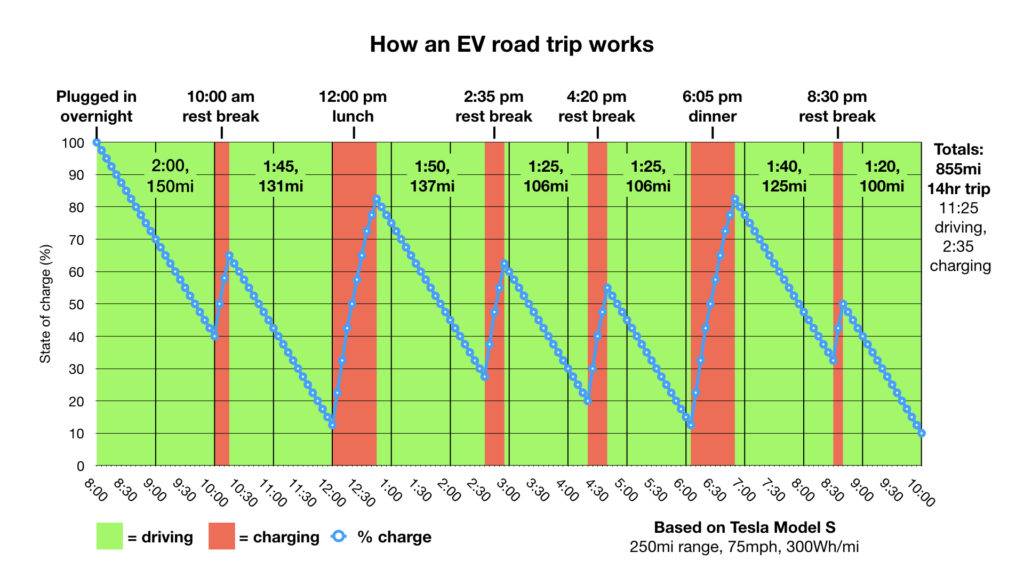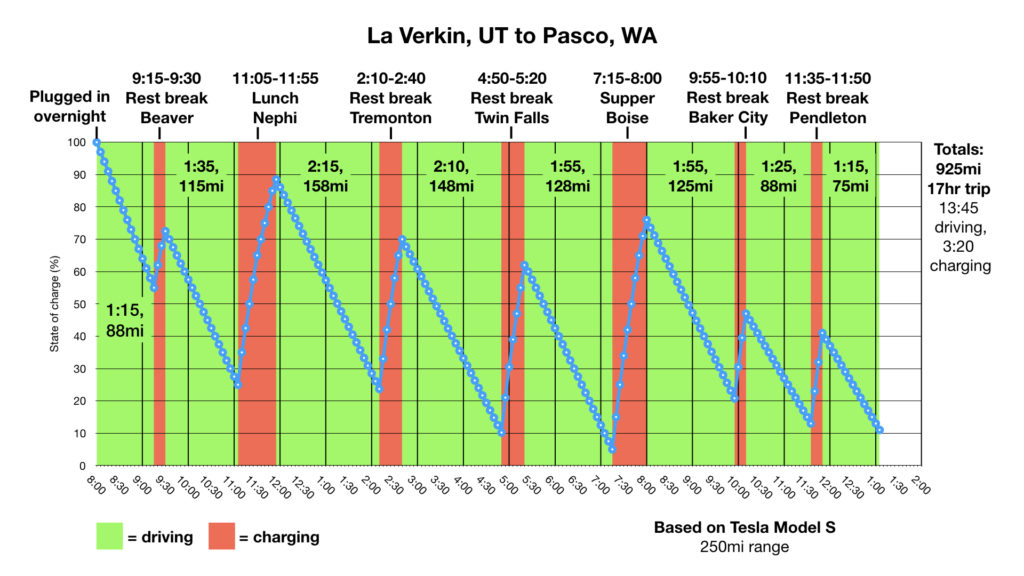
Many people believe that a downside of owning an electric car is the inconvenience of charging. But after more than a year with my Model S, and multiple cross-country road trips, I have found that charging is actually an advantage of EVs, and that it is more convenient, at least for me. That said, it is very different, and it took me longer than I thought it would to get my thinking switched over to charging instead of fueling. So let me explain how it works and why it might be easier than you expected.
AC vs DC charging
Before we talk about charging habits and the different ways to charge an EV, you need to understand that there are two types of charging: AC and DC. DC charging is usually super fast, for use on road trips, whereas AC charging is always slow, usually giving you a full charge overnight.
The battery has to charge on direct current (DC), but the power grid runs on alternating current (AC). So at some point, that AC from the grid has to get converted to DC for the battery. When you go to a DC charging station, such as Tesla’s Supercharger stations, this has already been done by the charger, so it is feeding the car DC, which flows directly into the battery. But chargers that do this conversion and output DC are very expensive, large, and heavy (see photo below), so you can’t really install one at home, and you certainly can’t fit one inside the car. But you can fit a miniature version of it inside the car. So when you’re at home, you simply feed the car AC power straight from your wall socket, and the car converts that to DC. So why is AC charging is always slow? Well, this miniature AC-DC converter inside the car can only output less than 1/10th as much current as a Supercharger can, so no matter how much AC current you give the car, that will always be the bottleneck. This does not apply at DC charging stations, since the power is already DC and it can bypass this bottleneck.

Home Charging
One major convenience benefit with EVs is being able to plug the car in in your own garage. It only takes a couple seconds to plug in, and you wake up to a “full tank” every morning. It’s like charging your cell phone.

Your garage might already have a suitable outlet for charging a car, but if not, it’s not a big deal to install one. You can charge on a standard 120v household outlet, but that will be very slow, adding about 30 miles of range overnight. It’s best to use a 240v outlet, similar to one a dryer or welder would use (you can get adapters for whatever sort of plug you have). These will fully charge the car overnight. The charging cord in the photo above came with the car, and all EVs come with a similar cord. If you don’t already have a suitable plug, you can install a home charger fairly cheaply and easily. I spent less than $50 on my setup (not including the meter, but I just put that in out of curiosity; it’s totally unnecessary), but I did the work myself. Electrician rates will vary if you have to hire someone, but a pro should be able to install an outlet in less than two hours in most cases.
DC fast charging on long trips
Home charging is a breeze, when you’re around home, but what about when you want to drive farther? It’s quite easy, IF you have a Tesla. Tesla has built out a fairly impressive fast-charging network in the last 5 years, but it can only charge their cars (for now). Other charging networks are slowly catching up, but as of early 2019 they are still not nearly as complete as Tesla’s. Here’s how Tesla’s charging network looks:

This charging infrastructure is complete enough to make travel easy for 95% of the trips you’ll need to make, although there remain some spots where you have to go out of your way to charge. Keep in mind this network is still rapidly growing, with a station being added about every two days in the US. So far I’ve visited about 50 different stations, and I’ve Supercharged at least 100 times total. The car makes it extremely easy to find stations, since the in-car navigation system already knows where all the chargers are. In the case of Tesla, it will automatically plot in charge stops any time you’re navigating farther than you can go on a charge. It even predicts how much charge you’ll have when you get there, and how long you’ll need to charge before continuing your trip.

By far the most common question I get at the charging stations is “How long does it take to charge?” If you’ve been asking this and getting unsatisfactory answers, that’s because it’s not quite that simple. It’s hard to answer this question concisely, so bear with me. The charge rate is not linear, so it starts out charging really fast, but as the battery gets “full”, it slows down. So you’re never going to sit there and wait for the last 20% of your charge, because that’s the part that takes forever. You’re just going to unplug at maybe 70-80%, and hit the road again. That way when you get to your next stop, your battery will be low enough to charge quickly again. You get the first half of your charge in about 20 mins, but you’ll be waiting at least another hour for the last half. My typical charge stop is about 20 mins, except if I’m eating a meal, then it’s however long the meal takes. Below I’ve prepared a graph that illustrates how a typical road trip goes. So to answer “How long does it take to charge?”, on average I spend 12-14 minutes charging for every hour I drive, but 90% of this time is while I’m eating or otherwise occupied.


I find these graphs best represent how the trip actually goes, and help to visualize the actual length of charge stops. If you look at the line on my lunchtime charge stop in Nephi, you’ll see that I got about 2/3 of my charge in the first half of the time, because the charger was slowing down as the battery got up into the 80-90% range.
Charging at hotels, restaurants & other destinations
There are a lot more AC chargers than most people realize, tucked in the back of packing lots with no real signage letting you know they’re there. But if you use an app like Plugshare, you can find them easily. AC chargers are cheap enough that a business owner can install several to help attract customers. Many hotels have charging, which is extremely convenient on road trips; you can wake up to a fully-charged car just like when you’re at home. Some restaurants have them too, which isn’t as useful, but it doesn’t hurt to plug in if you have the chance. Again, it only takes a couple of seconds. Finally, it’s always a good idea to have the charging cord your car came with in your trunk. I’ve stayed with several family members and relatives away from home, and they’ve all had an outlet at a convenient location where I can charge overnight.

I hope this was helpful, and if you have any questions feel free to contact me. I’ll be happy to help out and/or add info to this page.
